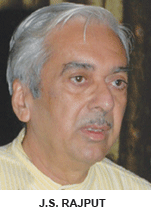Towards real quality education
 JS Rajput is former director of NCERT and National Council for Teacher Education
JS Rajput is former director of NCERT and National Council for Teacher Education
Under s. 19 of the historic right to free and Compulsory Education (aka RTE) Act, 2009, all schools imparting elementary (classes I-VIII) education countrywide were obliged to fulfill certain infrastructure and other norms as specified in a special Schedule of the Act, within three years from April 1, 2010. According to s. 19 (3), the prescribed authority “shall’’ withdraw recognition of all elementary (primary-upper primary) schools which fail to meet the infrastructure and other prescribed norms and force their closure. Elementaries which continue to function without recognition will be liable to pay a fine of up to Rs.100,000 and Rs.10,000 per day “during which such contravention continues’’ (s. 19 (5)).
The three-year deadline under s. 19 of the RTE Act ended on March 31. Yet more than 90 percent of government schools remain deficient in terms of the norms prescribed in the Schedule. The consequence is confirmed by the highly-respected Mumbai-based voluntary organisation Pratham, which reports abysmal learning attainments, particularly in rural government schools.
Independent India began its tryst with education focusing on extending its outreach to ‘all’. Achievements on this front, though still inadequate, are not unimpressive. As early as the 1960-70s, it was accepted that investment in primary education has little meaning if primary dropout rates were not checked. This was confirmed by the National Policy on Education (NPE)-1986/92 which emphasised access, participation and attainments, giving learner attainments formal recognition. Consequently several Centrally-sponsored schemes including Operation BlackBoard, UP Basic Education Project, Bihar Education Project, DPEP and finally the SSA, were launched to help state government schools. Moreover NPE-86 also emphasised strengthening and restructuring of teacher education and teacher training institutions in confirmation of the time-honoured adage that ‘no people can rise above the level of its teachers’.
For the first time, teacher education institutions (TEIs) were recognised as the key to quality improvement in school education and to prepare youth for higher education. Liberal grants were made to state governments to establish District Institutes of Education and Training, Colleges of Teacher Education and Institutes of Advanced Studies in Education. At the apex-level, a National Council for Teacher Education (NCTE) was established by an Act of Parliament in 1993 to maintain norms and standards, and encourage research and innovation in teacher training programmes.
Unfortunately, because of policy implementation failures at the Centre and in the states, none of these initiatives have paid off to expected levels. State governments gradually became dependent on the Centre for ever greater grants, with several unwilling to create regular positions of teachers and teacher educators being sanctioned under Plan schemes of the Central government on the pretext of ‘who would fund these after the Plan period is over’! Some states were prompt in recruiting support staff preferring to appoint principals on deputation, thus killing the chances of freshness, change of environment and work culture in host institutions. Moreover, the great ‘innovation’ of appointing para-teachers became convenient for bureaucrats to “tide over the resource crunch”, even when qualified teachers were available.
This reckless messing with teacher education and training has extracted a terrible price. When the Uttar Pradesh state board conducted an eligibility test of its incumbent teachers in 2011, only 9 percent passed. And in 2012 when the Central Board of Secondary Education (CBSE) conducted the Central Teacher Eligibility Test (CTET), the pass percentage was a mere one percent. Clearly, very little is being achieved by teacher education institutions countrywide. Raising TEI standards will require a herculean effort, but it needs to be given top priority.
One of the prime causes of the dramatic rise of the People’s Republic of China on the world stage is the communist leadership’s initial focus on school education in which the government, community and also non-resident Chinese participated enthusiastically. It’s indeed a globally accepted truism that the most attractive building in every Chinese village is inevitably the local school. In India, on the other hand, even in the metros government schools are defined by broken window panes, non-functioning toilets, drinking water shortages and unhygienic mid-day meals. In Rajasthan 8,000 schools are without drinking water and 15,000 schools don’t have separate toilets for girl children. The story is no different in other states where Central funds are siphoned off or are unutilised for years.
Well-equipped, adequately staffed and functional schools and TEIs are the building blocks of quality education in every nation. A countrywide teacher recruitment drive, firm resolve to eradicate teacher absenteeism, community and corporate participation in infrastructure development, and raising the annual (Centre plus states) outlay for education to 6 percent of GDP, are urgent initiatives required to regenerate faith in the government’s pledge to provide quality education for all.
Other articles by JS Rajput:






 JS Rajput is former director of NCERT and National Council for Teacher Education
JS Rajput is former director of NCERT and National Council for Teacher Education










Add comment